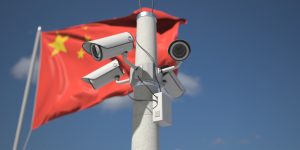Ongoing protests in Iran have been nothing short of an existential challenge to the Iranian regime’s legitimacy and its hold on power. This is chiefly so because schoolchildren and teenagers have been playing a leading role in keeping the momentum, which, in turn, has made it more difficult for the regime to apply its usual method of mass suppression and brute force.
In response, there are emerging signs that Tehran is beginning to rely more heavily on AI-powered technologies to both prevent crowds from gathering and better identify the participants. Speaking to reporters in Tehran, Moosa Ghazanfarabadi, the head of Majlis’s judicial commission, suggested that the need for a heavy police presence on the streets can be eliminated if efforts to equip the security forces with smart technologies, including AI-powered face recognition, are accelerated. More worryingly, officials have started issuing strongly worded statements warning protesters that the security forces will soon start using surveillance cameras to identify and arrest offenders.
As part of its long-term strategic agreement, Beijing has agreed to transfer its digital surveillance knowhow to Iran while simultaneously working with Iranian officials to set up smart cities using Chinese-made technologies. The agreement has the backing of Iran’s Supreme Leader Ali Khamenei, who has long been worried about loss of national sovereignty and what he calls Western infiltration in Iran’s cyberspace. Given the two sides’ near identical views on human rights and liberal democracy, moreover, the ideological ground for such cooperation is already there.
To this end, local media reports indicate that 15 million cameras have already been installed across 28 cities in Iran, transferring data to two control centers: one in Tehran and one in an unidentified location in China. Tiandy, a Chinese company, is reportedly in charge of supplying both the cameras and technical knowhow for their operation via its Tehran office.
The accuracy of these reports, one must note, cannot be taken for granted. However, it is beyond any doubt that such collaborations are taking place. In fact, Mahmoud Nabavian, a parliamentarian and head of the Majlis Commission 90, has indicated as much by labelling cyber cooperation with China as a pivotal national security matter.
Unsurprisingly, cyberspace has been at the front and center of ongoing protests in Iran. It is where Iranians can express their views and showcase the regime’s brutality, learn how to assist those exposed to tear gas and/or treat minor gunshot wounds, and, perhaps most importantly, communicate among themselves with a higher sense of security. Their personal security as well as their ability to withstand the regime’s brutality, therefore, could be at risk should Beijing continue to beef up the regime’s security apparatuses. That prospect will be detrimental to the cause of freedom in Iran.
As such, Iranian opposition needs to match its current efforts in courting European and American governments with a parallel one aimed at Beijing urging China to halt its cyber cooperation with Tehran. In doing so, they ought to assure China that its interests will be not jeopardized should there be a change of hands at the top of the power echelon in Tehran.
For its part, allowing Beijing to demonstrate the suitability of its technologies – and, more importantly, its technological model for governance – via Iran would be a huge blow to the United States’ efforts to retain its technological supremacy over China as well as its struggle with Beijing over the broader question of internet governance and responsible use of (cyber) technologies. China is already the leading supplier of technologies commonly associated with smart policing and smart cities to a number of Middle Eastern countries, and that passive stance on the ongoing protests in Iran would simply further boost China’s status as the region’s technological partner of choice. This is all the more so since the region is set to witness an increase in the number of environmentally induced protests.
Based on anecdotal evidence from recent environmental protests in Iran, such protests tend to bring out entire families onto streets. This makes it more difficult for regional states to use force against them since protesters include children and the elderly. As such, it is highly likely that states will rely more heavily on AI-powered technologies in their drive to stem out public protests in their infancy. Put otherwise, policing in the Middle East is likely to undergo fundamental changes by becoming more high-tech oriented.
A U.S. failure to reverse China’s inroads in this sector would have catastrophic commercial and strategic consequences for Washington. More broadly, the Biden administration’s commitment to a “free, open, prosperous, and secure international order” would sound hallow should it fail to meaningfully support the Iranian protesters, prospect that would only embolden U.S. rivals to push for their own visions of new global order more aggressively.

































